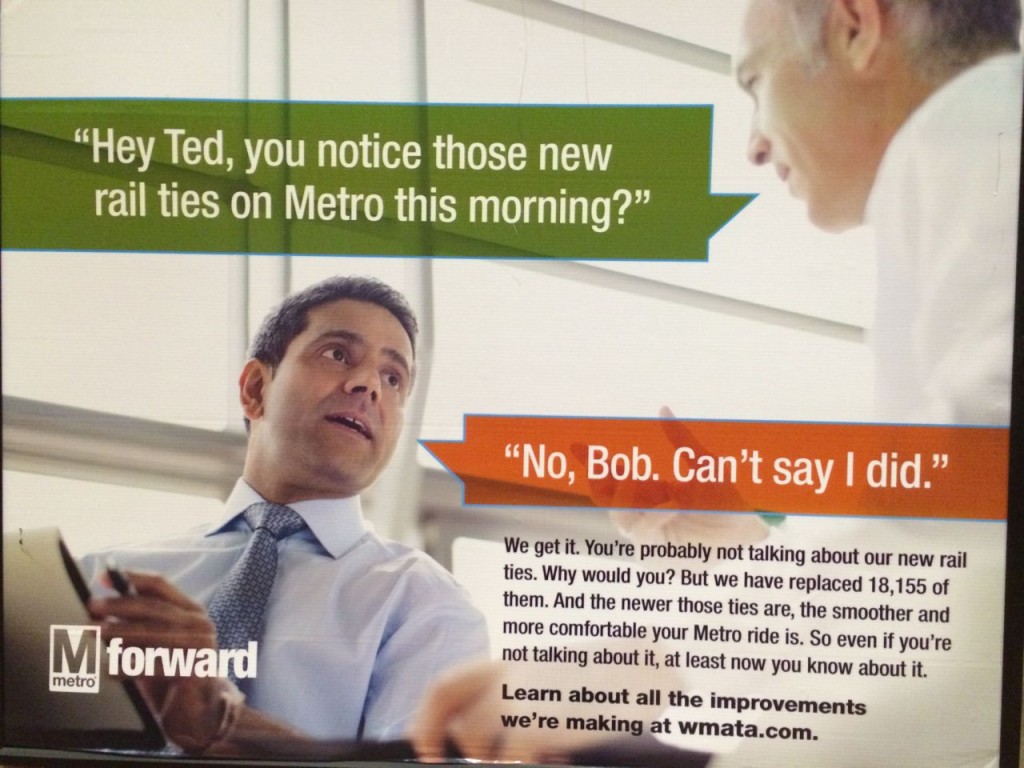Dear WMATA,
I saw your new ad while I walking into the Metro the other day. That is, the new ad where you tell your riders that your installing new rail ties to give us a more comfortable rise. Considering the purpose that rail ties serve, I am hopeful this type of maintenance will also give us customers a safer ride, but I’m not going to quibble on that. First, I would like to thank you for at least not insulting your customers, making an incredibly sexist stereotype, or presenting a vague statistic with absolutely no context that really conveys nothing in this ad, like you did in a certain ad from this new series of ads. I would also like to commend you on doing actual maintenance on your rail system. As an engineer, I am more aware than many of how important and needed regular maintenance is, and from what I have heard in the news, you weren’t actually aware of this fact until several years ago.
However, I do have a question for you about these new rail ties that you admit that we, the customers, might not notice. Exactly how would you like to your customers to notice these fantastic new rail ties? I mean this in all seriousness. After I saw this poster, I made a point of looking at the rail ties while I was standing on the platform waiting for my train. Both my originating and destination stations on this particular day were underground, and what I noticed is that there were no rail ties underneath the track in front of the platform. The rails were held in place by metal bracing of some sort that was attached directly to the concrete beneath the tracks and did not tie the two tracks together. As my name Geeky Girl Engineer might suggest, I am in fact a geeky engineer, and thus I became intrigued by this metal bracing holding the tracks at the platform. Thus far my internet searches have not led me to information as to what these braces are called, but since the braces only hold one track, they don’t seem to actually be rail ties. However, I could be wrong, and if you would like to educate me on what they are called, I would be happy to learn about it (in all seriousness).
The other thing I noticed about the track in the station, is that it is really hard to notice the rail ties or braces. To begin with, the station is dark. Second, the area where the track is, is mainly different shades of black as it’s rather dirty. I wouldn’t expect it to be clean, but the darkness makes it difficult to see any level of detail. Also, the platform tile closest to the edge is rather textured, and this makes it uncomfortable to stand there for very long to examine the tracks. I realize the textured tile is a safety design to make people realize how close to the edge they are and to keep people from standing there while waiting for the train and thus potentially falling onto the track. I think this is a good safety, and I am certainly not arguing against it. I am just pointing out that between the textured tile and simply not wanting to get too close to the edge, conditions are not really conducive to a person examining or admiring your new rail ties.
As for the rail ties that are under track between stations, well, those are kind of hard to see also. The Metro, as you are of course aware, is underground a significant portion of the time. There is no way to view rail ties at all while the train is underground. There is no way to view anything outside the train while the train is in motion underground. Quite frankly, you should be aware of this. I also looked at the track while the train was in motion above ground. I was able to view the track and see that there are wood ties holding the track in place, but that honestly was about it. Again, the train was in motion making it difficult to really examine details of the ties. I couldn’t say whether the ties I viewed were new or old. I’m not actually sure how I would be able to tell the difference. I’m fairly sure that old ties would be dirtier and probably darker than new ties, but I am not sure to what degree. Presumably if I saw an old and a new one side by side, I could tell the difference, but except for that case, I am not sure how I would. Thus, it would be nice if your ad touting your new rail ties would have educated me on how to tell the difference.
Again, I commend you for your maintenance work. I thank you for not insulting me or stereotyping me. However, I think you might want to rethink your ad. For safety reasons, I think it would be best if you did not encourage your customers to examine your rail ties.
Your observant and educated customer,
Geeky Girl Engineer

